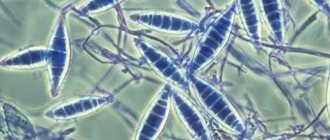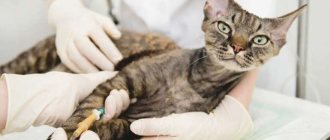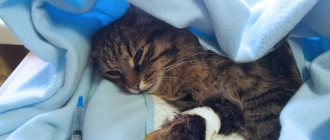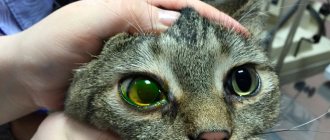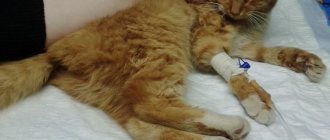Types of skin diseases
According to their variety, all skin diseases in cats are divided into several large groups, namely:
- parasitic;
- bacterial infections;
- allergy;
- other pathologies.
Diseases caused by parasitic infestation can be such as:
- ringworm;
- flea infestation;
- mite infestation.
A fairly common skin disease is flea infestation. If you do not pay attention to the presence of the problem in a timely manner and do not remove the parasites, then this can be complicated by dermatitis, which is of an allergic nature. The main symptom is severe itching throughout the animal’s body.
Fleas do not live on a cat's skin, but only feed on blood. The entire main process of life activity and reproduction occurs in secluded places in the apartment. This must be taken into account when treating an animal. Therefore, the therapy process includes treating the skin of the cat and the room. For this purpose, special preparations are used. Treatment is carried out in several stages to destroy adults and their eggs.
Among fungal skin diseases in cats (see photo in the article), ringworm should be highlighted. It can be transmitted to humans from animals. Microsporia is characterized by a high rate of spread, gradually involving more and more new areas of the animal’s body in the pathological process.
Skin diseases in cats also include tick-borne infections. It is very important to learn to distinguish between them, since each has its own separate treatment regimen. These include:
- scabies;
- demodicosis;
- otodectosis;
- sarcoptic mange.
Scabies is a mite-borne infection of the skin of animals. It can be provoked by microscopic scabies mites. They are present on the skin of animals at any time, but are activated only when the body's resistance decreases.
Demodicosis is a dangerous tick-borne infection. The risk of infection mainly occurs during the warm season. Its symptoms are quite painful, since the disease covers large areas of the skin. By parasitizing under the skin, mites cause hair loss, the formation of pustules and redness.
The cause of otodectosis is often insufficiently good care of the animal. The accumulation of wax in the ears and dirt can become a breeding ground for ear mites. The cat constantly shakes its head and suffers from severe ear itching. If the required measures are not taken, the animal’s condition will deteriorate sharply.
Skin diseases in cats caused by bacterial infection have two forms of development, namely dry and wet. These include eczema, acne, bedsores. If an animal has suffered a serious illness or a complex operation, then the recovery period requires him to be immobile, which is fraught with the risk of bedsores. They form at the site of prolonged contact with litter tissue.
Prevention of diseases in cats. Veterinarian recommendations.
Recently, the population of domestic cats has been growing. Future owners find their pets at the poultry market, from experienced or novice breeders, or even just on the street.
At the same time, the number of infections and hereditary diseases that veterinarians and cat owners have to deal with is growing. How to avoid problems in the future long life of a cat? Is it possible to prevent these problems? A number of diseases have this possibility. Let's look at the most common diseases of cats, as well as ways in which you can never encounter these diseases.
Infectious respiratory diseases of cats (rhinotracheitis, calicivirosis ) is the general name for acute infections that are characterized by inflammation of the mucous membranes of the upper respiratory tract, oral cavity and conjunctiva. Young cats are predisposed to these diseases. The main source of infection are sick cats or animals that have been carrying the virus for a long time. Often these diseases occur when animals are kept in groups (kennels and shelters), as well as after mass events (exhibitions, breeding shows, etc.). Cats can become infected through contact and also through airborne droplets. The incubation period varies from 2 to 14 days.
The symptoms of these diseases are varied - this includes elevated body temperature (on average 39.5-40C), discharge from the eyes and nose, ulcerative lesions in the mouth, refusal to feed and drink. Shortness of breath, cough, ulcerative keratitis are also symptoms of calicivirus and rhinotracheitis.
The diagnosis is usually established using PCR diagnostics
What is the prevention of these diseases? Everything here is quite simple - vaccination! Timely. Annual. Particular attention should be paid to the need for control diagnostics for latent virus carriage of all breeding animals, taking into account the high probability of sexual and intrauterine infection. The most common vaccines for the prevention of viral infections in Russia are Multifel-4, Nobivak Trikat, Quadrikat.
Diseases of the reproductive organs are common among cats, the most common of which is pyometra. Pyometra, also called suppurative metritis, most often occurs in aging cats. Of course, this pathology occurs only in uncastrated animals. The disease consists of the accumulation of pus in the uterus due to inflammation of the endometrium. Animals that have experienced hormonal effects are most often affected. Pyometra can also develop after estrus or childbirth, with general immunodeficiency and ovarian diseases. Purulent metritis is more common in nulliparous animals. Although the latter fact is not one hundred percent proven.
Prevention of this pathology is also quite simple - early castration of the cat. It is a mistake to assume that a cat needs to be neutered after its “first heat” or it is a mistake to assume that a cat “must give birth.” Early castration is a significant guarantee of the absence of cancer in an aging cat, and will not in any way affect its behavioral reactions.
Diseases of the urinary system in cats occupy one of the leading places in terms of frequency of occurrence. One of them is cystitis, inflammation of the lower urinary tract and the walls of the animal’s bladder. And although cystitis itself is not a dangerous disease, its complication can be a serious problem and lead to the appearance of urolithiasis and even blockage of the urethra.
There are many reasons that lead to cystitis. These include diabetes, bacterial infections, long-term use of steroids, bladder stones or sediment, and low fluid intake. The symptoms of cystitis in cats are somewhat similar to those in humans. Namely, difficulty urinating, urinating “past the tray”, active licking of the genitals, urine has a pungent and even fetid odor. Another symptom is hematuria. The owner of a cat may notice on the white litter that wet stains from his pet’s urine have a pinkish tint. This indicates the cat has blood in its urine.
To diagnose cystitis, it will be necessary to examine urine and conduct an ultrasound examination of the urinary system. Often, to clarify the diagnosis, a biochemical study of blood and urine is required.
How to avoid cystitis in your beloved cat? Try not to change the location of your pet's toilet. Your cat should always have fresh water to drink. You need 2 litter trays if you have one cat. More litter boxes means more cats. Minimize the stress factor in the cat. If a cat spends its “toilet” on the street, then there should still be one litter tray in the house - the cat should always have a backup option.
Vomit. Vomiting in a cat can occur for a number of reasons; the vomit itself can be bloody or mixed with bile. Vomiting is a very diverse symptom.
Several causes of vomiting. Firstly, vomiting can occur with severe worm infestation. Intestinal helminths, while living inside the host, release toxins that poison the cat. Secondly, inflammatory processes in the gastrointestinal tract. They are not always of non-contagious etiology. Most often, these inflammations are due to infectious diseases. The next point is banal overfeeding of the cat. Injuries, bruises, and cerebral swelling are also possible causes of vomiting. Another reason is intestinal obstruction, stagnation of feces in the thick gastrointestinal tract. If the cat begins to vomit and the urge becomes regular, the cat must be brought to an appointment at the veterinary clinic for a detailed diagnosis.
Prevention of vomiting consists of timely vaccination and deworming of the cat. It is important not to self-medicate your pet. Brush the hair regularly or use special pastes to dissolve the hair in the cat's gastrointestinal tract. Do not overfeed the cat, monitor the quality of the food.
It is impossible to plan everything in the life of a domestic cat. Regular examinations of your pet by a veterinarian can detect or prevent disease in your cat and give a lot of positive emotions to you and your little family member.
Gargalyk Sergey Stepanovich. Veterinarian, ICU, ITC MBA, Moscow
The material was prepared with the support of the Farmina brand
Main causes of skin disease in cats
Skin diseases in cats are quite common, and this is due to various provoking factors. These include:
- allergic reactions;
- pathologies of internal organs;
- insect bites;
- poor environmental conditions;
- genetic predisposition;
- infections caused by pathogens;
- feeding poor quality food;
- low physical activity.
Often, owners feed their pets low-quality food, which can lead to allergies in the animal. The allergen can accumulate in the body for a long time, and then manifests itself in itching, rashes, and hair loss.
Some skin diseases in cats are hereditary. The disease is passed on to offspring. Sometimes it can take a generation to manifest itself. The most dangerous factor that causes disorders to appear is the effect of infection. Most viruses, bacteria and fungi enter the body of a pet and cause serious skin lesions that are transmitted from cat to person. Therefore, you need to carefully monitor the animal’s condition and promptly seek help from a veterinarian.
What diseases do cats have?
Below is information about the most common diseases of cats and cats.
Diseases of the urinary system of cats
Among the common ailments are problems with the urinary system.
Cystitis or urolithiasis may occur, which may result in your four-legged friend walking past the litter box. There may also be a strong odor and blood in the urine. This is not a dangerous disease, but it can cause more serious negative consequences. By the way, this manifests itself due to sand in the bladder, diabetes, and lack of fluid. In such a situation, a thorough diagnosis must be carried out.
According to statistics, 10% of cats exhibit urolitic syndrome in one way or another, and these figures are growing. Most often, urolithiasis occurs in cats and female cats that have undergone castration or sterilization, which is associated with the loss of activity of the animal.
After castration (sterilization), you should change regular food to specialized food for sterilized animals. Low-quality food can cause not only urolithiasis in cats, but also many other diseases of the stomach, liver, heart and other organs. Therefore, you should feed your cat high-quality food, which is best selected with the help of a veterinarian.
As a preventative measure, it is worth providing direct access to clean water. You also need to eliminate stress associated with the litter box. Experts advise installing 2 trays per animal. At the same time, the environment of the tray should not change, the toilet should be convenient in size, and should always be clean.
Ringworm
This is an infectious skin disease in cats, a photo of which shows the peculiarity of its course, provoked by mold fungi. It can affect not only animals, but also humans. Infection mainly occurs after close contact with a sick individual.
Fungal spores are very stable in the environment. At risk are mainly animals in a state of immune depression, those with a poor diet, elderly and young cats.
It is important to diagnose the disease in a timely manner, as it requires long-term, complex treatment. Among the main symptoms it is necessary to highlight the following:
- hair thinning;
- itching;
- the appearance of white flakes in the wool;
- Nails may become deformed and acquire a yellowish tint.
Treatment of ringworm should begin immediately after detection, as there is a high risk of human infection. To make an accurate diagnosis, you need to go to a veterinary clinic for examination.
For therapy, Miconazole or Thiabendazole ointment is prescribed. It is forbidden to bathe a cat that suffers from lichen, as this contributes to the spread of fungi throughout the animal's body.
Skin parasites
If your cat behaves restlessly and is constantly itching, then most likely the cause is fleas. If the animal has the opportunity to walk outside, it may also become infected with grass mites. By carefully examining a cat's fur, you can easily detect fleas themselves or their excrement in the form of very small black specks. Usually, it is not difficult for owners to independently identify skin diseases caused by parasites in cats. The photo gives an idea of what traces of their vital activity look like.
To remove fleas, you can use drops applied to the animal's skin near the withers. It is recommended to buy such drugs in veterinary clinics, since in pet stores there is a higher chance of finding counterfeits. You should also wash the floors, carpets, and bedding - flea eggs can remain in all these places. A special collar is also an effective means of prevention, especially for cats that are outdoors.
Dermatitis
Among skin diseases in cats, dermatitis especially deserves mention. Depending on the causes of its occurrence, it is divided into the following types:
- thermal;
- chemical;
- traumatic and medicinal;
- parasitic and infectious.
Regardless of the type of disease, purulent inflammation of the skin is observed. A serous secretion or ichor may also appear. The most common is miliary dermatitis. It is an allergic reaction that occurs in response to the bites of blood-sucking parasites.
Symptoms of dermatitis can vary. Basically, the disease manifests itself in the form of various redness, cracks in the skin, swelling, purulent discharge, and peeling of the skin.
Treatment is selected depending on the cause of dermatitis, as well as the severity of the inflammatory process. For injuries, apply external dressings with ointment, which has an antiseptic and astringent effect. Preparations with propolis have a good healing effect. If the damage is caused by chemicals, then initially it is necessary to neutralize its destructive effect.
Bacterial infections
Acne, like wounds and cuts, can cause bacterial skin diseases in cats. Symptoms may vary depending on how the inflammatory process occurs. With the dry type of the disease, dense nodules and flaky crusts appear on the skin. The wet course of the disease is characterized by wetness of the infected areas, redness and the formation of pustules.
Dry lesions are treated with antibacterial agents Miramistin and Levomikol. Wet areas are treated with drying sprays. If the inflammation does not go away, a course of antibiotics is prescribed.
Allergy
Allergy is considered a fairly common skin disease in cats. It can occur against the background of any provoking factors, in particular, such as chemicals, new food, plants, dust, cosmetics and perfumes. Among the main symptoms it is necessary to highlight the following:
- itching;
- temperature increase;
- rashes;
- decreased immunity;
- formation of ulcers.
If the cat is free-range, then the likelihood of allergies increases, since on the street the animal encounters many provoking factors. Treatment of allergies in cats should be started only after consultation with a specialist.
Eczema
The spread of inflammation can be caused by many different factors, which include:
- poor animal care;
- reaction to an animal’s collar or synthetic clothing;
- hormonal disorders;
- presence of bacteria and parasites;
- unbalanced diet;
- problems with the liver, stomach or kidneys.
The first symptom of skin disease in cats is the appearance of redness and itching. The spots that appear are hot to the touch. After scratching, the animal's skin becomes covered with bubbles filled with liquid. With dry eczema, they burst and dry out, then a crust forms, which begins to peel off. This type of disease often becomes chronic.
With wet eczema, the contents of the blisters leak out, which provokes the formation of pustules. The disease occurs in an acute form, but if it is detected in a timely manner, it can be treated very easily. The hair on the affected area is cut off, and then treated with ointment and antiseptics. The pet is prescribed a vitamin complex and antibiotics.
Scabies
It is very important to promptly recognize the symptoms of skin diseases in cats. A photo of scabies will help to separate this disease from others and provide the correct treatment. This is a rather unpleasant disease that occurs as a result of the vigorous activity of ticks. These parasites, when they get on the skin, begin to make passages in it and lay eggs. This causes significant discomfort to the animal. Among the main symptoms it is necessary to highlight the following:
- severe itching;
- redness and inflammation of the skin;
- hair loss.
Only a veterinarian can accurately determine whether a pet has scabies. Under a microscope, many mites can be clearly distinguished. Treatment mainly consists of topical ointments and antiparasitic injections.
If the animal’s body is sufficiently weakened due to the activity of parasites, then it is necessary to improve the cat’s nutrition and select general strengthening vitamins. Prevention is also important, as many flea drops also protect against ticks.
All types of diseases of domestic cats: symptoms, diagnosis, treatment and prevention
When a pet is sick, it is always a difficult ordeal not only for it, but also for its owners. Many diseases are easier to prevent than to treat; other cat diseases can be noticed already by the first symptoms and timely treatment can be started. Of course, it is not always possible to treat a cat on your own, but it is advisable for every owner to know at least the most common diseases and their first symptoms. Conventionally, diseases in cats can be divided into groups:
Infectious. The cause of the disease is pathogenic agents; Viral. Diseases that are caused by viruses; Age. Over time, cats' immunity weakens; age-related diseases include kidney failure, diabetes, and heart disease; Parasitic. These diseases appear when parasites enter the animal’s body; Genetic. Most often found in artificially bred breeds such as Persian cats.
Many diseases develop quickly, so if alarming signs appear, it is better to contact a veterinarian without delay. Convulsions, lethargy, photophobia, changes in temperament, drooling or vomiting, loss of appetite, discharge from the nose or eyes, weight gain or emaciation, poor general condition - it is better to visit a doctor immediately, this way you will save the animal’s life.
Urinary tract infection. Frequent urination, persistent defecation past the tray, the cat meows when trying to go to the toilet, extreme thirst - these symptoms may indicate the development of urolithiasis, cystitis or diabetes. The disease is accompanied by severe pain and can cause complications on the kidneys. Also, urolithiasis can manifest itself by the presence of blood in the urine. Its main causes are metabolic disorders and unbalanced nutrition.
As for treatment, the remedy is prescribed by a veterinarian: in the initial stages, diet correction and light supplements are sufficient; in later stages, surgical removal of stones and cleaning of the ducts may be required.
Prevention of the disease is the correct diet, refuse cheap ready-made food, make sure that the animal has access to clean drinking water. If you provide natural food, balance the diet; often it is the abundance of fish that causes the accumulation of excess phosphorus in the body and the deposition of salts.
Calcivirus infection. A viral disease in which the mucous membranes of the eyes and respiratory tract become inflamed, the incubation period is up to one week. If the form is acute, the animal has a high temperature (up to 40 degrees), wheezing, cough, discharge from the eyes, photophobia, and pain in the larynx. There is also a chronic form, which can be accompanied by trembling of the limbs, disruption of the functioning of internal organs, and ulcerations.
Anti-inflammatory drugs are used for treatment, both orally and locally. Limit the contact of other animals with a sick pet; recovered cats cannot be used for breeding, since the kittens become infected during the first feeding. You can get vaccinated to create immunity: the most favorable age is from 3 months to 3 years.
Peritonitis. This is an inflammation of the peritoneum in cats and very young kittens; it is caused by a virus. The disease is accompanied by loss of appetite, dehydration, fever, shortness of breath, damage to the eyes, liver (yellow skin), lungs, and kidneys.
Treatment is possible only in the clinic: fluid is removed from the cat’s abdominal cavity and antiseptic and diuretic drugs are administered. Peritonitis causes a fairly high mortality rate in animals, so a visit to the veterinarian should not be delayed.
Ringworm. One of the most common diseases caused by a fungus. Even if your pet does not go outside, you can transfer microspores on clothes or shoes; ringworm can be transmitted to humans, especially people with weakened immune systems and children.
Symptoms: the appearance of red spots, the hairs in these places fall out, then skin crusts and scales appear. Ringworm is mainly localized on the paws, ears and face of the cat. Ringworm is diagnosed using Wood's lamp or laboratory tests. If you direct the light of a lamp onto the affected area, it will turn emerald. The doctor prescribes antibiotics, topical antifungals, and vaccinations.
Ear mite. A pet can also “catch” an ear mite; the main symptoms are: restless behavior of the pet, the cat often shakes its head and tries to get into the ear with its hind paw; after 1-1.5 weeks, a brown or black coating or crust appears on the inside of the auricle.
You can treat ear mites at home; it is very important to complete the treatment, since the development cycle of the parasite is 21 days. You need to regularly clean your pet's ears, apply special drops, and sometimes use medications that are applied to the withers (the capsule acts against both fleas and ticks or worms). Read more in the article - “Ear mites in cats”
Subcutaneous mite. Ticks are dangerous parasites that can carry various viruses and microspores. It is quite difficult to detect them on the animal’s body until characteristic signs appear. Demodicosis is caused by an endoparasitic mite, the animal's immunity decreases, the skin becomes bald in some places, and rashes appear. Ticks are small, they mainly parasitize on the belly, tail, around the bridge of the nose, eyes and ears of the pet. The skin in the infected area becomes covered with dense tubercles, turns red, peels, and hair falls out. Whether there is a tick or not can only be determined through tests.
To treat mites, special shampoos and ointments are used, and drugs with antiparasitic properties are administered.
Helminths. There can be many symptoms that a cat has worms: loss of appetite, excessive thinness, vomiting, bloating, poor coat condition, chronic diarrhea, apathy - all this may indicate that the cat has worms. Often, the body of cats is affected by roundworms (they cause bloating, increased appetite, decreased activity), nematodes (feed on the cat’s blood, and are therefore deadly to it), tapeworms (often found in animals infected with fleas), heartworms (appear in weakened or painful animals). cats, they are carried by mosquitoes).
Treatment for worms in a cat is prescribed by a specialist after taking tests. Practice good hygiene as some types of worms can be transmitted to people. Feed the animal properly, do not allow the cat to catch rodents, carry out preventive measures, give anthelmintics.
Respiratory tract infections. In cats, they are very similar to colds in humans. Typical syndromes are: fever, sneezing, loss of appetite, runny nose, eye damage, tearing and so on. Depending on the severity of the disease, medications are also prescribed: antibiotics, vitamins, drops, and in some cases injections. Infections can cause complications, so contact your doctor promptly.
Panleukopenia or feline distemper. The panleukopenia virus is quite common in nature. Signs of the disease are: vomiting, depression, diarrhea, deterioration of coat condition, poor appetite, convulsions, fever. In many adult cats, the disease may be asymptomatic or may resemble signs of poisoning. The veterinarian makes a diagnosis after examination and laboratory tests. Upon palpation, you can detect enlargement of the abdominal lymph nodes and thickening of the intestine.
The cat is prescribed a diet, given medications to stop vomiting, and given vitamins and fluids to correct dehydration. It is better to carry out timely vaccination against distemper at 8-12 weeks, and then repeat every year.
Rabies in cats. We would like to note right away that this disease is fatal, so carry out timely vaccination, especially if your cat walks outside. The causative agent of the disease is a neurotropic virus; it is localized in the tears, saliva and brain of the animal; generally, the first symptoms appear a month or two after infection. Cats' mood changes rapidly, they begin to swallow inedible objects, and they salivate profusely. Then the cat begins to show aggression, its voice changes, its swallowing muscles become paralyzed, and as a result the animal goes hungry. Paralysis of the entire body develops within a few days, and the animal dies. The infection is transmitted through contaminated saliva or a bite; such a pet is dangerous to other people and animals. If a cat is bitten by an animal infected with rabies, you need to take it to the clinic and get an anti-rabies vaccination, then isolate it for 60 days and monitor its condition.
Demodicosis
This disease is caused by a microscopic mite that parasitizes the cat's epidermis. It mainly occurs in spring and autumn, when there is high humidity. Among the main signs of pathology, the following should be highlighted:
- rashes and scratches appear on the skin;
- hair loss occurs in some places;
- tubercles form on the body, and when pressed, a thick white liquid is released;
- The cat's skin turns red and crusts over.
Demodectic mite significantly reduces the pet's immunity, so if timely treatment is not carried out, the cat may die from a secondary infection.
Other diseases
Autoimmune diseases, in particular, such as vasculitis, systemic lupus erythematosus, pemphigus, are quite rare. They appear in the form of numerous rashes on the animal’s skin, which over time become pustules, ulcers or erosions.
Nutritional skin diseases appear as a result of an animal's unbalanced diet. They are characterized by the animal's weight loss, brittle and dry fur, and flaking of the animal's skin.
Fungal skin diseases in cats are characterized by baldness. The affected area develops light gray or white patches with thinned skin underneath. The presence of itching and its intensity largely depend on the degree of damage and the type of pathogen.
Treatment of a fungal infection should be carried out with means prescribed by the treating doctor. Depending on the strain of the fungus and the degree of damage, only local treatment or longer complex therapy with additional vaccination may be required.
Bacterial skin disease in cats is characterized by suppuration of existing wound surfaces, folds and scratches. Crusts, scales, blisters, and pustules form on the affected area. Basically, the pathological process affects only the superficial layers of the skin. Deeper lesions may indicate more serious problems. Antibacterial therapy should be started after bacterial culture of a scraping of the affected area of the skin and determination of sensitivity to antibiotics.
Cushing's syndrome
Skin diseases in cats caused by hormonal imbalances are relatively rare. One of these diseases is Cushing's syndrome. Its cause is excessive production of the hormone cortisol by the adrenal glands. The disease can also occur as a result of taking certain medications.
An excess of cortisol negatively affects the entire body. But on the skin, the manifestations of the disease are especially noticeable. The coat becomes thinner and then bald spots appear. The skin becomes thin and vulnerable to mechanical damage. The wounds do not heal for a long time. The tips of the ears become flabby and curled.
Treatment may include various measures, depending on the causes and course of the disease. If Cushing's syndrome is caused by taking cortisol-containing drugs, they are replaced with other drugs. If the cause is adrenal hyperactivity, drug therapy is prescribed. Sometimes they resort to surgery. It is effective when only one adrenal gland is not functioning properly. In such a situation, its surgical removal can solve the problem.
Carrying out diagnostics
To correctly recognize the disorder, you need to look at the description of skin diseases in cats with photos. Treatment should only be prescribed by a veterinarian, as some medications are toxic and can harm the animal. In some cases, a clinical examination alone is not enough, so the doctor prescribes other diagnostic methods, namely:
- urine and blood analysis;
- taking skin samples;
- allergy tests;
- bacteriological seeding of material.
Only after making an accurate diagnosis, the doctor prescribes the most effective treatment regimen.
Carrying out treatment
To eliminate the symptoms of skin diseases in cats, treatment must be comprehensive and prescribed by a qualified veterinarian. Therapy largely depends on the diagnosis made by the doctor. For fungal infections, antimycotic drugs are effective, in particular, such as Exoderil, Lamisil, and sulfur-based ointment.
To treat a cat's skin disease caused by bacteria, antimicrobial medications are prescribed. For external treatment, Aluminspray or Miramistin are mainly prescribed.
Viral infections are treated with antiviral drugs such as Maksidin. Local skin treatment is carried out with antiseptic agents. Allergies are treated with corticosteroids and antihistamines. However, you must first determine the allergen.
Baldness requires an individual approach for each animal. Therapy begins only after diagnosis and identification of the cause of the disease. The drug Amitrazine is used to treat scabies. Autoimmune diseases are treated with steroid drugs.
Allergic skin diseases in cats: photos and treatment
Allergies in pets are not uncommon. Its most common variant in cats is hypersensitivity to flea bites. Externally, such an allergy can manifest itself in the form of baldness of individual areas of the skin, itching, and the appearance of spots, the color of which can vary from pink to dark gray.
Treatment in this case consists of ridding the pet of fleas. In this case, the allergic reaction will manifest itself for some time even after the insects disappear. The symptoms will finally go away after 5-6 weeks.
In addition to fleas, allergies in animals can be caused by food or external irritants. Such cases are more difficult to treat. After all, identifying an allergen is not so easy.



